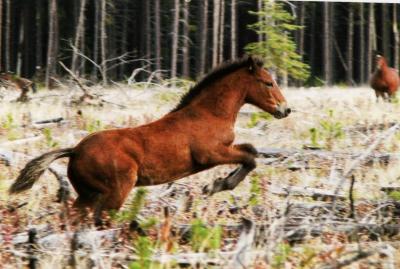What’s the difference between a wild horse and one that’s considered feral? A lot, according to some experts.
“The wild horse is completely independent of human beings and has been independent to survive in a wild landscape and contributes to the landscape over say, five or six generations,” says Maureen Enns, an artist / conservationist studying the animals.
“The feral horse is dependent to a certain extent, whether it’s (being receptive to) friendly greetings and receiving food from humans, and they don’t have the same bloodlines.”
For example, Enns says horses living near MacLean Creek, near Bragg Creek, Alberta, are feral.
“They wander through the campground, they pick up scraps of food, and I’m sure people feed them,” says Enns.
“They aren’t owned by anybody, but they are rounded up by people with permits to take feral horses and cull them. That is a very different animal than the animal that has been living independently and is part of the wild ecosystem. The real wild horses are wilder than deer, and have such a contribution in terms of equine behaviour, but also what is important to the landscape.”

The wild horses, she argues, are also wilder than the elk, for example, that roam in and around the Banff townsite.
“I’d say a feral horse is closer to these elk (than the wild horses),” Enns says, explaining the elk have lost some of their wild characteristics, because they’re not afraid of humans.
“So maybe we ought to look at that whole question again when we look at what is wild and what is feral – there’s almost a subspecies that is the wild horse that does contribute to the wild landscape.”
Dr. Claudia Notzke has travelled all over the world studying wild horse populations. The geographer and professor, who teaches at the University of Lethbridge, says today’s wild horses may be reintroduced wildlife, as they are genetically equivalent to horses that appeared 11,000 years ago – a fact proven by mitochondrial DNA.
“But many people cannot look at the wild horse any other way than as an artificially introduced species,” she says.
“And that has a powerful mythology connected with it, because wild horses must then do what alien species do – compete with native wildlife and destroy native ecosystems. And that’s simply not true.”
But Alberta Sustainable Resource Development categorizes all horses living outside a domesticated environment as feral, and therefore, not true wildlife because they believe they’re not indigenous to the area.
Officially, ASRD believes Alberta’s free-ranging horses are descendents of domestic horses used in logging, guiding and outfitting operations in the early 1900s. When these horses were no longer needed, they were set free. Since then, several generations of offspring have been produced and occupy an area mostly west of Sundre and Rocky Mountain House.
But some say this classification contributes to the attitude the animals aren’t worth anything and therefore can be readily disposed of.
It could also be the justification of those who are shooting the wild horses, says Bob Henderson, of WHOAS (Wild Horses of Alberta Society).
“We want to educate people that these horses are a natural resource and not just a feral, invasive species. It’s the biggest change we’d like to make, is changing the definition of feral, and refer to them as wild and free roaming. I think the word feral feeds into the mentality that they can just be shot.”
Majesty, pride and ingrained survival skills: That’s what Maureen Enns and others have observed, by witnessing wild horses roaming free in their own environment.
“As I’ve said before, the real wild horses are wilder than deer and I want to keep it that way,” says the artist / conservationist, who has been studying, filming and photographing wild horses in the Ghost Forest area west of Calgary.
A remote camera has captured some of the most fascinating behaviour.
“What makes the wild horse so interesting and so different from the domestic herd is how they operate within the herd, in terms of their respect for one another, how they care for the young stallions coming up….and when I think back to the definition of what is a wild animal, the wild animal respects one another. We as humans encroach on that respect, and it’s what gets us in trouble.”
A big reason for respect within the herd, says Enns, is because it’s necessary for survival in the wild.
“It has to have something to do with how nature must respond quickly to survive. The herds stay together and do so without a lot of fighting, which could cause injury, which could cause one to be taken by a predator.”
Enns, who often travels on her domestic mare, says she wouldn’t dream of riding her while in heat around other domestic horses – wild horses, however, are a different story.
“I know a (domestic) horse would come right up, approach within a few feet, strike out at my mare, and I could get hurt.
I feel safer on the range with the wild horses because of what’s been bred into these herds, in manners, and how to interface with each other.”
An example of this behaviour occurred when Enns saw a stallion, who she previously noticed had been pushed out of his herd by the head stallion, because he was trying to breed with some mares within the herd.
“He came up to me from across the marshland, to about 30 feet, and then he politely looked at me, looked at my horse, circled a few times, kind of chuffed and blowed, and then left, no problem. And I’ve seen that kind of behaviour with about eight other stallions.”
Another time, a group of stallions approached her mare, but because there was no invitation from her indicating it’s polite for him to come forward, they went elsewhere.
Stallions who are kicked out of their herds often run together in bachelor herds, much like deer. This offers them some degree of protection from predators.
But when they’re running within a herd that includes mares and other more vulnerable horses, stallions, can be very protective, says Doreen Henderson of WHOAS (Wild Horses of Alberta Society).
The domestic horses she rides west of Sundre are now more used to wild horse encounters, but that wasn’t always the case.
“A stallion once did a bit of a bluff charge towards us, he was snorting and blowing, shaking his head. And then he stopped – he was checking to ensure his mares and foals were safe, and off he went.”
From what Doreen and her husband Bob have seen, a typical herd of wild horses consists of one stallion, and up to three or four mares, a yearling and perhaps a couple foals.
“The stallion protects the herd, and he’ll die to protect his family,” says Bob.
“I can’t think of any other animal species that will actually sacrifice itself, the male for the female.”
Enns says in order to avoid a potentially deadly situation, she’s noticed wild horses tend to adopt a similar hiding technique known to deer.
“Deer freeze while in the forest to avoid detection. They’ll out-wait you half and hour if you don’t move, they’ll just stand there because they think they’re not visible. They’ll freeze in the shadows or behind a tree. And the reason they’re behind a tree, is to break up their profile. I’ve figured that out with the horses, why they always stand behind a tree. It’s for the same reason.”
An educated observer can tell right away these horses are wild, says Dr. Claudia Notzke, a wild horse expert out of the University of Lethbridge.
“They have a totally different aura and posture about them, and you can tell, intuitively, that it’s a wild animal, as opposed to a runaway stray horse. They act like wild animals, even when they’re unafraid.”
Notzke, who has observed wild horse populations all over the world, says apart from environmental adaptations, the animals have similar behavioural traits.
“That’s what unites them, that’s what makes them wild animals of the equine species,” she says.
Dust Bath
Grazing Disagreement
Herd Grazing
Three Wild Horses in Spring
Wild Horses in Winter

This shot of a mother and foal was taken from the hidden camera. The only sound comes from the camera inside the weather-proof housing.
Witnessing a wild horse in its own environment is a sight reserved for a lucky few. Here are accounts of what a wild horse sighting has meant to three different people:
Doreen Henderson
“We had turned this corner on Ranch Creek Road, west of Sundre, and we were on horseback. There were a couple mares and foals on the road and they had long, long tails hanging on the ground and they weren’t paying attention to us. But then the stallion noticed us and came charging towards us. He had a massive mane and a tail that drags on the ground. He looked mythical or something, not at all like your typical horse. His proud demeanor and everything about him, I don’t know. It was extraordinary.”
Maureen Enns
“On one of my first rides, I rode my mare into wild horse country and into this area that’s as close to pristine wilderness as you could get. And she’s going down the trail and she stops. She’s a very well-trained, forward-moving horse. And then she goes a little further and stops again. I thought ‘is she listening to something I’m not picking up on?’ So I started to ride in a circle, ever bigger as I rode, and she stopped again…and there is a herd, frozen, in the Aspens, in the deep shadows and all I can detect is a tail moving. And I realized she heard a signal the wild stallion or the lead mare gave the herd to freeze, as a deer would in the forest, to avoid detection, and she was obeying that. After that experience, I was completely hooked on learning more. I’m three years into it now, and every time I’m around a wild herd, which I don’t try to get close to because the real wild horses are wilder than deer and I want to keep them that way. They have such a contribution in terms of equine behaviour, but also, what is important to the landscape.”
Corleigh Belton
“I’m driving along the highway near Nordegg, and I saw a great heaping pile of horse poop on the side of the road. And I thought ‘well that is kind of funny’. It never dawned on me that could be the wild horses. It was fresh horse dung, and the further I drove in, a stud came out. I was across the road, but he stopped, and I stopped and watched him. And just to watch him was phenomenal. He knew what he was doing, he knew I wasn’t going to run him over, but it was almost like ‘here I am.’ He had a full mane, full tail, his muscular features were just unbelievable. It was a treat. I just stopped and said ‘wow, that is amazing.’ I bet very few people get to see a leader of his brood come out, in the middle of daylight, and stop like that. And spiritually, I said ‘thank you, grandfather, for giving me this special gift.’”
Maureen Enns takes us on a trip into the wilds to observe wild horses. This compliation of several trips from winter to spring has some amazing footage of the horses in the forests and in the marshland. The actual encounters with the wild horses are brief and infrequent – Marueen and her videographer, Roger Vernon, can travel for several days without seeing a single horse.
 A Galileo Educational Network Site
A Galileo Educational Network Site





